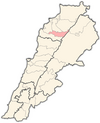Bsharri District
Hadsheet District | |
|---|---|
District | |
 Location in Lebanon | |
| Country | |
| Governorate | North Governorate |
| Capital | Bsharri |
| Area | |
| • Total | 61 sq mi (158 km2) |
| Population | |
| • Total | 97,000 |
| Time zone | UTC+2 (EET) |
| • Summer (DST) | UTC+3 (EEST) |
Bsharri District is one of the 7 districts (qadaa, قضاء) of the North Governorate, Lebanon.
Geography
The Bsharri District is a mountainous district. Most of the 26 villages composing it are at an elevation higher than 1.000 meters. The district is bordered by the Zgharta and Miniyeh-Danniyeh Districts to the north, the Koura District to the west, the Baalbek District to the east and the Batroun District to the south.

This district is a grouping of 26 villages. It has also one of the important landmarks of Eastern Christianity and Maronite history, the major part of the Kadisha Valley, the Qannoubin valley where Hermits have resided since around the year 600 C.E., the last being Father Antonios Torbey whose file in the Vatican is progressing toward beatification. He lived most of his life in the ancient monastery of Saint Elisha located in a grotto deep in the Qannoubin Valley. In this valley there is more than 26 monasteries all more than 1000 years old. At the top of this valley, sits the legendary cedar forest.
Population
The population of the district was estimated to be 76,831 by the Ministry of Social Affairs.[1] The capital of the district is Bsharri. The Ministry's estimate lacks credibility. According to the Daily Star, an English language Lebanese newspaper, a total of 40,000 people in the district voted in the 2005 elections. In addition the Ministry of Social Affairs[2] estimates that 39% of the Lebanese population was under 20 years of age which meant they were not eligible to vote and a 60% participation rate. Considering these factors the population may be more realistically estimated at 100,000 people.
The Bsharri district is predominantly Maronite Catholic, from here, five great priests were canonized and declared Saints. The most prominent is Saint Charbel from Beqa'a Kafra, well known all over the world for his many miracles. From here also the philosopher Gibran Khalil Gibran started his early life before he emigrated to United States.
The Abi Saab and Kayrouz family has resided in the Bsharri District since the 13th century,[citation needed] they were "protectors" of the Maronite area, then governors of the area of Kouwaiteh and then the area of Jebbeh of Bsharri and Zgharta during the period of the Directorates.[citation needed]
Towns and villages
(incomplete)
- Abdeen
- Bane
- Bani Saab
- Bazoun
- Barhalyoun
- Beit Minzer
- Bekaa Kafra (Saint Charbel Village)
- Bolla (Bella meaning beautiful)
- Blaouza
- Bqarqacha (From aramic B'qar Qosho meaning very cold)
- Bsharri
- Brisat
- Dimane
- El-Arz (Cedars of God)
- Hadath El Jebbeh (or Haded, as called by its citizens, after the god Haded)
- Hadchit
- Hasroun
- Kadisha Valley (the Holy Valley)
- Kanate
- Kanyour
- Mazraat Assaf
- Metrit
- Qnaywer
- Qnat
- Shira
- Tourza
- Wadi Qannoubine

